Archive for ‘Philosophical’ Category
Paper Doll Explains Aspirational vs. Inspirational Clutter
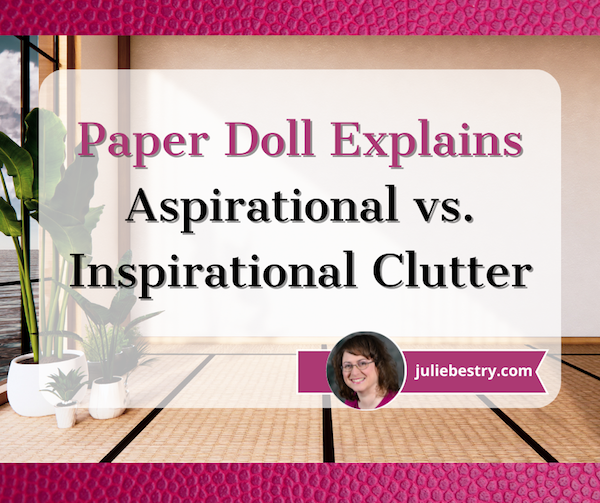
Do you ever think about all the different flavors of clutter?
A few years ago, I wrote The Boo-Hoo Box: Organizing Painful Clutter.
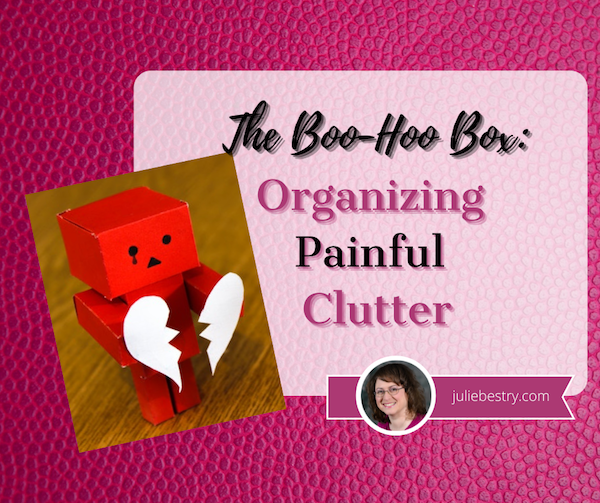
In that post, as a precursor to discussing the kinds of heartbreaking clutter people keep, I introduced some of the major categories of clutter, and this is worthy of a review as we explore today’s topic.
CATEGORIES OF CLUTTER
When working with my organizing clients, we tend to identify six different kinds of clutter (though these are only the main ones — there are others).
- Practical clutter — These are things that are useful, in and of themselves, like clothing, bedding, or kitchen implements. It’s not that we don’t need these things, but we generally don’t need so many (black skirts, frying pans) and we need to let go when specific items no longer suit our needs.
- Informational clutter — We keep documents and clippings, whether on paper or digitally, because we believe the information is valuable. The problem is that we rarely go back to consider how valuable something is now vs. when we acquired it, and we tend not to think about whether it might be better to eliminate (outdated) information, digitize it, or access the information anew via the internet to reduce the bulk.
- Identity clutter — Sometimes, the clutter we keep is an excess of items that we feel help define us. Our clutter may not be useful (in a practical sense) but we perceive it as useful for defining who we are or who we wish to be seen as. Our clutter might say, “I’m the kind of person who runs marathons [or wins spelling bees or bakes from scratch].”
- Aspirational clutter — This type of clutter accounts for all of the items in your space which support hobbies you tell yourself that you are going to take up, but never really do. Whether you are saving a closet full of fancy papers and Cricut gadgets for the day when you finally decide to become a scrapbooker or amass shelves of books on the topic of “How To [train championship Greyhounds, write a novel, become a successful crypotocurrency miner],” there comes a point when you’ve got to recognize that you have an excess of items supporting a life you don’t really lead.
- Nostalgic clutter — Nostalgia is defined as “a sentimental longing or wistful affection for the past, typically for a period or place with happy personal associations.” Obviously, life is made better by the things that truly remind us of happy (or happier) times, but an excess of nostalgic emblems of our past can fill up our homes in the present and prevent us from having space in our lives to make a future. Sometimes, we just have to take photos of those ancient macaroni art projects and discard the originals, letting them crumble in peace.
An excess of nostalgic emblems of our past can fill up our homes in the present and prevent us from having space in our lives to make a future. Share on X - Painful or sad clutter — This category encompasses things that remind us of bad times or bad people.

Break-Up Photo by Kelly Sikkema on Unsplash
Clients tend to have a good handle on both practical and informational clutter. Someone might save useful things that they used in the past (or acquire in the present) because they might be useful now or in the future; the same is true of clippings or online information in case they might be desired later.
Identity clutter, nostalgic clutter, and painful clutter is almost always about the past. But as we’ll see, aspirational clutter is about the future.
WHAT KIND OF CLUTTER IS IT REALLY?
Too often, we think of clutter as if it were a monolith. Yes, a house full of clutter is daunting, but identifying what kind of clutter something is helps us determine why we’re holding onto it so we can (eventually) confidently let it go.
I do prospective client consultations by phone; this gives me a chance to get to know what a client may need and helps them determine whether they like my philosophy and can bear my goofy sense of humor. Early on, I ask them to describe what kinds of clutter they have.
I’m not looking for a hierarchy or categorization, just a sense of what “stuff” is bothering them. Usually, I hear something like: too many clothes that don’t fit (or don’t fit in the closet); outgrown children’s toys; an overwhelm of papers, books, and digital media. This gives me an idea of the tangible items needing attention. However, once in people’s homes, I’m able to see that clutter is not so simple.
For example, a closet filled with maternity clothes may reflect that that a client has spent a number of years bearing and raising kids. If she’s in her 30s, this may just be practical clutter. She’s been pregnant one or more times, acquired clothing through shopping and gifts, and hasn’t yet winnowed the collection down. However, if the woman is older, perhaps in her 50s or 60s (and her own children are already having babies), she may be holding onto the clothing out of a strong sense of nostalgia, remembering fondly when her family was small (but growing) and possibilities were endless.

It’s even possible that now that her children are adults, she may feel adrift and unneeded. At this point, all of the maternity clothes can be identity clutter, items that people hold onto out of fear of becoming unmoored from their identities. If the woman’s sense of self is closely tied to being a mom, the idea of letting go of those clothes may feel very much like letting go of one’s sense of self. Until a client is prompted to discuss the possessions in question, the category of clutter may not yet be clear.
I recently spoke with an older couple who were hoping to downsize in advance of an eventual move to senior living. When I asked them to describe how they felt about downsizing, the husband recounted that every time he thought about letting go of materials related to his career and hobbies, it made him feel like they (and now he) lacked worth.
Ouch. That showed incredible self-awareness on his part, as well as a pain point. I gently asked him to consider that his identity exists in his memory and in the memories of all who worked with him and knew him.
His adult daughter, also on the call, riffed on some things we’d discussed earlier about donating items, and reminded him that these could be a living legacy if donated to an organization related to his former profession; his materials could find a new life with someone who needs them rather than just rusting away in a storage unit, unused and unnoticed. His identity could actually get refreshed through possessions finding a new life as something other than clutter.
Proud possessions from the past can become clutter in the present and the future, but self-awareness and analysis can open our eyes to options and opportunities.
ASPIRATIONAL CLUTTER VS. INSPIRATIONAL CLUTTER
This brings us to considering things we have acquired (and continue to acquire) for the future.
After a client and I discussed painful clutter and how the Boo-Hoo Box can counter emotional pain, she mentioned that she had a lot of items she’d purchased to inspire her to overcome emotional distress. She said that what I called aspirational, she considered inspirational. It’s a great point, and I think it might be helpful to look at how aspirational and inspirational clutter can be similar and how they are different.
Aspirational Clutter
The way I look at it, aspirational clutter is made up of items that support hobbies or activities you tell yourself that you are going to take up, but never really do. They’re gathering dust. It’s clutter because they can be used, but you aren’t using them. Examples include:
- Crafting and art supplies — Over the years, I’ve visited a lot of clients homes where cabinets and even rooms are overflowing with yarn and needlework supplies, boxed up sewing machines, canvases, paints and brushes, and packaged art projects. They’re bought with the aspiration of tapping into creativity and expressing artistic talents. But so many people accumulate art supplies without actually dedicating time to create art.
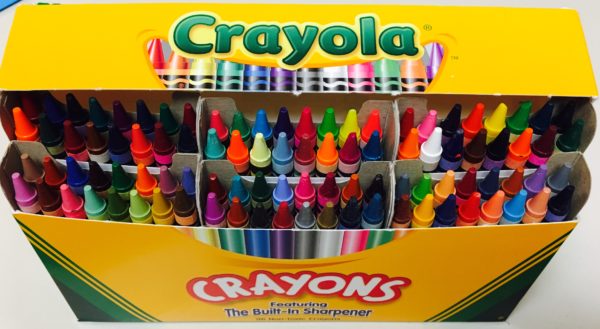
- Exercise equipment and fitness devices — From gyms to treadmills and Pelotons to fitness trackers, they exist because we aspire to be fit and svelte. Gym memberships can be financial clutter; home equipment and trackers might be tangible clutter. We buy them because we aspire to improve our physical health and believe they’ll get us to work out and track our activity. But if we never unbox the trackers or walk on the treadmills and end up using the equipment to hang cute workout clothes we wear (but don’t work out in), it’s aspirational clutter.
- Gardening supplies — Got pots? Seeds? Trowels and knee pads and garden storage? Oh, my! Do you aspire to cultivate a green thumb or make everyone in the neighborhood association green with envy? If you never slice open those seed packets or remove the price tags from the tools, you’ll make your self green around the gills with how much you’ve spent on untouched aspirational clutter.
- Outdoor gear — My sister once had a blind date lean across the table and ask, “Don’t you just love camping?” No, she did not. We do not. But some people would be better off buying stock in REI rather than throwing down money on bikes, boats, hiking gear, camping equipment. Do you aspire to be an outdoorsman or outdoorswoman but never make the time or take the first step to go outside?

I love this Anne Taintor card, sold by Quiltinia. You can also get magnets at Artworks.
- Clothes that don’t fit your life — I went through a stage where every time I went shopping, I tried on little black dresses, suitable for fancy dinner parties. But I never went to dinner parties. I was craving a wardrobe for an imaginary life to which I aspired. (TV in the 1970s and 1980s set me up for thinking I’d be going to a lot of dinner parties, even Mary Richards’ famously bad ones!)
- Musical instruments — When digging through client’s basements or closets, I find dusty electric keyboards or drum sets, or out of tune pianos. Having the intention of learning an instrument (or revisiting childhood lessons) is understandable, but if you never get an instructor, schedule lessons, or practice, it’s an unfulfilled aspiration.
- Cooking gadgets — I get it. The pandemic made everyone aspire to be a sourdough artiste. But if you’ve got a plethora of bread machines and pasta makers, and drawers bulging with immersion thingies, but you order Door Dash every night, your plan of becoming the next Barefoot Contessa might be a pipe dream.
- Language education tools
- Photography equipment
- Travel Gear
These last three tend to go together. People buy books, recordings, and software courses to learn foreign languages. They purchase luggage and compression cubes, plus all manner of travel guides, to use on those trips where they impress the populace with their fluency in the native language. And oh, the cameras, lenses, and accessories they buy with the intention of learning about f-stops and taking social media influencer-level photos on those trips.
But if they never practice the language, figure out how the photo equipment works, or book the trips, it’s all just layers of aspirations that go unachieved. Shopping provides that dopamine hit that scratches the itch in our novelty- and reward-seeking brains. But when purchases go ignored, the clutter sneers at us.
(Aspirational clutter is a close cousin of nostalgic or identity clutter. If you formerly used something and keep it to maintain a happy connection to the past or how you see yourself, it could be nostalgia- or identity-driven, but if you’ve never used it at all, that’s purely aspirational.)
Inspirational Clutter
If aspirational clutter is “stuff” that supports who you’d be if you’d do something, inspirational clutter is the tangible reflection of ways to motivate you not to do a specific activity, but to live a “better” way. Inspirational clutter is (usually) commercially-created and message-oriented, designed to make you live out certain values:
- Motivational posters and wall art — If it features an inspirational quote or affirmations and reminds you to “Live, Laugh, Love,” but it’s gathering dust in the closet or you’ve stopped even noticing it on the walls, it’s inspirational clutter.

Cluttered Wall of Inspirational Clutter Photo by Mikechie Esparagoza
- Calendars, sticky notes, and affirmation cards – Ditto. All the positive, empowering, and encouraging messages in the world, no matter where you stick them (if you’ll pardon the expression) start to become like wallpaper (or “parsley”) if you don’t notice them.
- Self-help and personal development books — Obviously, as a published author myself, I believe in the power of books that focus on organizing, productivity, self-improvement, personal growth, etc. But buying the latest Brené Brown book and leaving it unread on the bedside table won’t really inspire you. It will mock you.
- Spiritual or religious books and recordings — My clients often own recordings of sermons from their houses of worship (or, quite often, family members’ houses of worship, sent to them with kind intent). The content of the material is inspirational, but there is nothing inspiring about old cassettes, DVDs, or prayer group handouts collecting dust in random corners. Words unread or unheard are meaningless.
- Mindfulness apps — Digital motivational clutter could be its own category. Whether it’s an app for guided meditation, relaxation techniques, or mindfulness exercises, if you’ve never even signed in because it requires setting up yet another password, what does it inspire?
- Blank journals — Wow, people buy (and get gifted) a lot of blank journals. Although I’ve never been able to get the hang of journaling, the research is clear that writing by hand, whether gratitude journals or Julia Cameron’s morning pages, has the positive effect of fostering optimism. But piles of blank notebooks (ignored year after year) foster nothing but dead trees!

Gratitude Journal Photo by Gabrielle Henderson on Unsplash
- Seminar notes — You can gain tremendous insights at workshops, seminars, and personal development conferences. If going to these events inspires you, keep going! But whether you painstakingly take notes you never look at again or buy the workbooks and lesson plans the speakers and coaches sell, if they are still shrink-wrapped years or decades later, free yourself from the obligation to go through them “someday.”
HOW DO ASPIRATIONAL AND INSPIRATIONAL CLUTTER COMPARE?
There are definite similarities between the two types of clutter.
Perceived Value — Sure, there’s monetary value. You (or someone) spent money on this stuff. But there’s also the value you place on their potential to bring you closer to the life you want to live.
Aspirational clutter (before you recognize it as clutter) holds potential for doing, while inspirational clutter is valued for its anticipated ability to change how you think, feel, and (possibly) act.
Emotional Attachment — Both types of clutter have emotional heft, and decluttering without dealing with the underlying issues can lead to emotional distress.
Aspirational clutter may represent ambitions or dreams that have never been fulfilled, and letting go of the items before reckoning with that can feel like dashing those dreams, leading to a sense of grief. Letting go of inspirational clutter before coming to terms with the diminished (or imaginary) value may evoke a loss of self-worth.
Intentional Acquisition — People generally acquire both types of clutter with good intentions. Whether you buy equipment for a hobby or motivational wall hangings to boost your mindset, the initial intention is positive: a way to enrich your life.
In both cases, the common thread may be the lack of intentionality. Not all gifts are equally desired by the recipient. Ahem.
The differences between aspirational and inspirational clutter come down to the why and the what:
Intended Purpose — Again, aspirational clutter builds up when people intend to pursue hobbies or activities, either out of true desire or hope of becoming “the kind of person who (does X).” Conversely, inspirational clutter comes not from a desire to do something, but to be a better person, either in their own eyes or the eyes of others.
Actual Outcome — Whatever the desired outcome, the two types of clutter tend to yield different effects.
Aspirational clutter often leads of feelings of guilt or frustration over wasted money, lost space, or inconvenience. Inspirational clutter usually has a less deleterious effect; people feel less like they’ve “failed” if they’re still being reminded to “Be the change they wish to see in the world” than if they have spent hundreds or thousands of dollars on hobby materials that fill the closets and cabinets.
Inspirational clutter tends not to yield the same level of guilt or shame as aspirational clutter; it’s also more easily ignored.
REDUCING ASPIRATIONAL AND INSPIRATIONAL CLUTTER
As I previously said in defining aspirational clutter, there comes a point when you’ve got to recognize that you have an excess of items supporting a life you don’t really lead.
There comes a point when you've got to recognize that you have an excess of items supporting a life you don't really lead. Share on XApproach reducing both types of clutter from logical and emotional perspectives.
Reality Check
For aspirational clutter, get real. Analyze how functional the items really is; is it so old, it’s not useful anymore? Is it way beyond the skill level you’re reasonably likely to achieve?
How feasible is it that you’ll invest time in pursuing the activities you’ve ignored? Questions like, “Have I used this item in the last year (or ever)?” are less productive than asking, “Am I willing to start doing this thing (scheduling lessons, getting out in the garden) this month?” If you’re not going to prioritize time for an activity, send the aspirational clutter packing.
Groove is in the Heart
For aspirational clutter, talk about your emotional attachment to the what’s behind the items; what do they mean beyond their ability to create art or make music or improve the garden? Reflect on the significance of the objects, and whether they still represent what you want to do, or if they are echoes of a former version of yourself.
For inspirational clutter, reflect on whether the items are in alignment with your current goals and values. Do you actually need these items to achieve your true and higher self?
Do the messages on all those wall hangings still genuinely inspire and uplift? Do they actually sometimes make you feel pressured or inadequate? Or are they parsley, unnoticed and unappreciated? Surround yourself with fewer messages, but ones that truly resonate with who you want to to be right now.

Oscar Wilde Quote Photo by Matej
Think Gratitude, Not Guilt
Even enjoying a sense of freedom, people sometimes feel guilty about letting clutter go on so long. Shift your focus toward being grateful that you’ve developed the ability to recognize your evolving self.
If you like, take Marie Kondo’s advice and express gratitude to (or at least for) things you’re letting go of, knowing they can bring joy to someone who will want, need, and use them.
Once you understand the similarities and differences between aspirational and inspirational clutter, it’s easier to identify your own examples and assess them more critically. Cultivate spaces that authentically support your goals and well-being.
Organize Your Annual Review & Mindset Blueprint for 2023

The holiday week is the perfect time of year to plan for next year, to set goals and intentions, and get a fresh start. Of course, you don’t need a new year for that. Check out Organizing A Fresh Start: Catalysts for Success from this past September to see all the ways you can find inspiration for fresh starts quarterly, monthly, weekly, and each day.
But before we can design the coming year, it’s essential to review the past, and to get a handle on what worked (and didn’t) so that we can use that knowledge to set us up for future successes.
LOOK IN THE REAR-VIEW MIRROR
On the very businesslike side of the productivity realm, this is called an annual review. People in the corporate world often experience this in terms of a sometimes-feared, often-maligned annual performance review.
That’s where you tell your boss how you think you did during the course of the year (in hopes of a raise, promotion, and an atta-boy/atta-girl), and your boss tells you how the company thinks you did (in hopes that you’ll be so thankful to have a job, you won’t notice that any extra money is going to the CEO’s newest yacht).
But a personal annual review, which can cover both lifestyle and professional topics, is solely for your own benefit. It’s to help you figure out the who, what, where, why, and how of your past year so that you can find the common threads (or snags) in your successes (or challenges).
Gather Supplies
The process is as formal or informal as you’d like, but I encourage you to start with some of the tools you use to create the structure of your year:
- planner or calendar
- journal
- correspondence — email or text threads — with your best friend, accountability partner, or mastermind group
- a sense of your values
With a pen and paper (or fresh Evernote note or blank document), sift through what you’ve written and logged about your life over the past year. Where did you go, with whom did you meet, and what did you do? As if you were reading a mystery, you’ll find yourself noticing clues to patterns in your year. (Feel free to wear your Sherlock Holmes deerstalker hat.)

There are a few kinds of clues, and depending upon your life and work, as well as what you value, different clues will yield evidence for making different kinds of decisions.
Know Your Values
Speaking of values, these are not uniform across nations, regions, communities, families, or even periods of our lives. In the United States Army’s Basic Combat Training, they focus on seven values: loyalty, duty, respect, selfless service, honor, integrity, and personal courage. Conversely, the immigration portal for the Durham Region of Ontario, Canada lists Canadian values as “equality, respect, safety, peace, nature – and we love our hockey!”
If you’re not quite sure how to identify the values that help you plan your life, here are some great resources:
Nir Eyal’s 20 Common Values [and Why People Can’t Agree On More] (Eyal is the author of Indistractible: How to Control Your Attention and Choose Your Life.)
James Clear’s 50 Core Values list (Clear is the author of Atomic Habits.)
Brené Brown’s 118 Dare To Lead List of Values (Brown is the author of Dare to Lead, as well as Daring Greatly, Rising Strong, and The Gifts of Imperfection.)
The Happiness Planner’s List of 230 Core Personal Values
Some people highly value achievement and contribution; for others it’s balance and inner harmony. For me, it’s knowledge, usefulness, and humor.
We’ll get to how to use your values in a bit. For now, it’s just helpful to go through one (or more) of these lists and identify from three-to-five overarching values that resonate with you and how you aspire to live your life.
Ask Qualitative Questions
The Good
- What challenges made me feel smart, empowered, or proud of myself this year?
- What did I create?
- What positive relationships did I begin or nurture?
- Who brought delight to my life?
- Who stepped up or stepped forward for me?
- What was my biggest personal highlight or moment I’d like to relive?
- What was my biggest professional moment I’d want to appear in my bio?
- What’s a good habit I developed this year?
The Neutral
- What did I learn about myself and/or my work this year?
- What did I learn how to do this year?
- What did neglect or avoid doing out of fear or self-doubt?
- What did I take on that didn’t suit my goals or my abilities?
- What was I wrong about? (Note: Being wrong isn’t a negative. Not one of us knows everything. In the words of Dr. Maya Angelou, “Do the best you can until you know better. When you know better, do better.”
The Ugly
- What challenges made me feel weaker or less-than?
- Whom did I dread having to see or speak with this year?
- Who let me down?
- Whom did I let down?
- What did I do this year that embarrassed me (professionally or personally) or made me cringe?
- When did I hide my light under a bushel?
- What am I faking knowing how how do? — Instead of pretending you know how to do something but are choosing a different path, ask for help. Make decision about what to do from a position of strength rather than weakness.
- What’s a bad habit I regret taking up or continuing?
- Where did I spend my time wastefully or unproductively? (It’s social media. For all of us.)
- Where did I spend my money wastefully or unwisely? (Target? Let’s take a poll. Was it Target?)
Although most of these are questions I’ve developed over the years, the inspiration for including this list came from the Rev Up for the Week weekly newsletter put out by Graham Allcott, author of How to Be a Productivity Ninja, among other titles.
Organizing A Fresh Start: Catalysts for Success

[Editor’s note: This post originally appeared on September 26, 2022. Rosh Hashanah will not be until October 2 in 2024, and changes each year, as the holiday is dependent upon a lunar calendar. The remainder of the content of this post is still accurate.]
As I go to press on this post, it’s about to be Rosh Hashanah, the Jewish New Year. (We’re going into the year 5783, though as the old joke goes, I’ll be writing 5782 on my checks for weeks.)
What I always liked about the idea of the Jewish New Year was the opportunity for a fresh start. Sure, in Western culture, we already have one (in either August or September, depending on your part of the country) with the beginning of a new school year. That always brings new clothes (and the jettisoning of old ones), new school supplies (especially brand new crayons and notebooks), and new opportunities.

Apples & Honey photo by Igal Ness on Unsplash
One of those opportunities, especially as we all got older (moving from elementary school to middle school, or middle school to high school) was that we could create ourselves anew, be seen as a different kind of person.
Let’s say you’d had a reputation as a goody two-shoes; you could make yourself over as a bit of a rebel. A ne’er-do-well punk could become an athlete lettering in varsity track. An academic washout could study a trade, and a beauty school dropout could rejoin the old gang. (Any resemblance to the plot of Grease is purely coincidental.)
But if you found yourself slipping back into old habits (messy lockers, messy friendships, messy study habits), the clean slate of a new year in the guise of a millennia-old religious and cultural tradition sure could be appealing. And if the start of the school year didn’t keep you on the straight-and-narrow toward a more perfect version of you? Well, Rosh Hashanah offered another shot.
And if that didn’t work, well, the new calendar year was only another 90 days or so away.
FRESH STARTS FOR THE NEW YEAR(S)
The best known annual fresh start is January 1st; worldwide, people explore New Year’s resolutions, to various degrees of success. Indeed, because of the difficulty of maintaining adherence to wholesale changes in one’s self, I often encourage alternatives to resolution making, like having goals, themes, phrases, or words of the year, such as those I wrote about in:
Review & Renew for 2022: Resolutions, Goals, and Words of the Year
Organize Your Life: The Truth About Resolutions, Goals, Habits, and Words of the Year
That said, some people still hold to the idea of making big changes when there’s a marker on the calendar to do so. If that’s you, I recommend reading what my colleagues and I have had to say at:
Join The Resolution Revolution
New Year’s Resolutions: Professional Organizers Blog Carnival
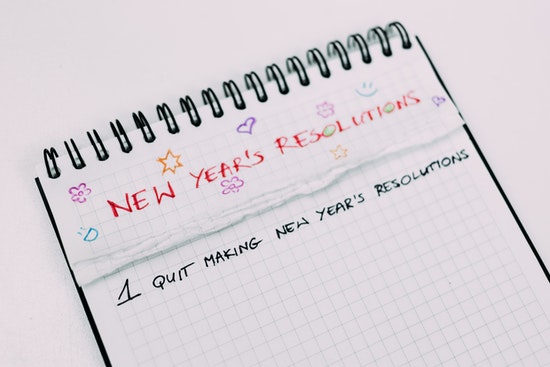
And, of course, your annual fresh starts aren’t limited to the new calendar year, new school year, or Rosh Hashanah. Worldwide, particularly in East and Southeast Asian nations and cultures, there are numerous religious and cultural new year’s observations, and you could choose any of those to give yourself a burst of inspiration.
Because lunar calendars (similar to the ones that make the Jewish holidays like Rosh Hashanah and Hanukkah bounce around the Gregorian calendar) are measured differently from what we use, these holidays don’t sync up to January first, nor do they fall on the same Gregorian calendar date each year.

These include:
- Chinese New Year — between late January and mid-February
- Lunar New Year (in Vietnam and other Southeast Asian nations) — between late January and mid-February
- Seollal (Korean New Year) — January or February, on the second new moon after the winter solstice
- Tết Nguyên Đán/Spring Festival/Lunar New Year/Vietnamese Lunar New Year — late January to mid-February
- Nyepi (Balinese New Year) — March
- Nowruz (Persian/Iranian New Year) — between March 19th and 22nd
- Aluth Avurudda (Sinhalese New Year) — April 13th or 14th
- Puthandu (Tamil New Year) — follows the spring equinox and generally falls on April 14th
- Willkakuti (Andean and Amazonian New Year) — June 21st
- Mayan Aboriginal New Year — mid-July
- Diwali (Marwari and Gujarati New Year Day) — mid-October to mid-November
- Raʼs as-Sanah al-Hijrīyah (Islamic New Year) — early July to late August
- Australian Aboriginal Murador New Year
As you can see, there are year-round “New Year’s” observations, if you’re looking to get a bit of institutional support for your new beginnings.
The meanings behind these holidays are as varied as the cultures from which they derive. Some focus on joy and celebration, others on introspection and focused self-improvement. The point is not to suggest that you necessarily observe religious or cultural New Year’s holidays or festivals, and certainly nobody should indulge in cultural appropriation.
Rather, consider these as inspirational opportunities to forgive yourself for any backsliding, identify ways you can tweak your efforts, and give yourself a motivational pep-talk.
FRESH STARTS EVERY QUARTER
If you work in the corporate world, you’re probably used to buzzwords about splitting the year into quarters. “Let’s ramp this up in 2Q!” or “We’re looking at projections for fourth quarter.” The year is carved into four 12/13ish week quarters with new collaborative goals structured into that temporal space.
Indeed, Brian Moran’s best-selling book and website, The 12-Week Year, is focused on the idea of setting shorter-term goals quarterly instead of annually. Rather than trying to transform yourself in a binary way, from “not this” yesterday to “this” today, this program posits that there’s an advantage to carving the year up into shorter 3-month blocks vs. trying to make changes on an annual basis.
Toxic Productivity Part 3: Get Off the To-Do List Hamster Wheel
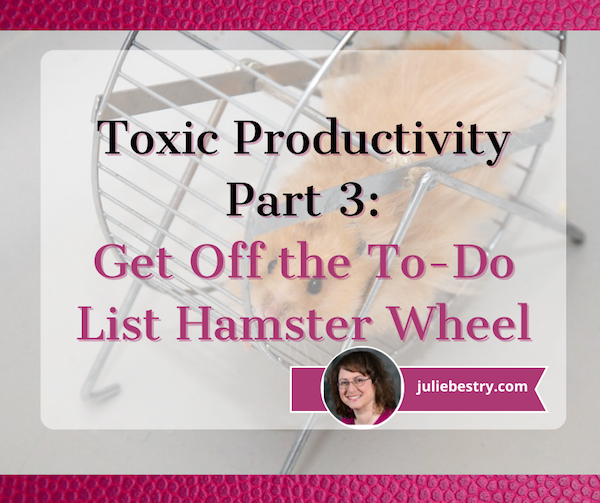
“Nothing is so insufferable to man as to be completely at rest…. He then feels his nothingness.”
~ Blaise Pascal, Pensées
Two weeks ago, in Toxic Productivity In the Workplace and What Comes Next, we looked at the external forces that drive unsustainable expectations and eventually burnout. We also examined what other industrialized nations have been doing to stem this dangerous trend.
Last week, in Toxic Productivity Part 2: How to Change Your Mindset, we examined productivity dysmorphia, the disconnect between objective achievements and our emotions about those accomplishments. When we experience productivity dysmorphia, the very act of pursuing productivity (to the neglect of all else) means we lose the ability to savor or enjoy what we have accomplished.
That second post focused on the ways to change our mindset about productivity. We examined how hedonic adaption gets us so used to our status as achievers, as worker bees, that eventually we will be unable to sustain that behavior and burn out. We reviewed the research that showed our brains require downtime and countered the many myths that exist about productivity.
Most importantly, we started a discussion regarding the role of work (and achievement, in general) in our identities, starting with Charlie Warzel and Anne Helen Petersen asking “Who would you be if work was no longer the axis of your life?” and considering the “finitude” of life (in the words of Oliver Burkeman and the Stoic philosophy of Seneca). We left off in contemplation that our value is not in what we do but in who we are — in being, not doing.
Today, we’re going to explore developing an appreciation of being over doing, seeing how our actions need not be achievements, per se, but can be experiences, valued solely for the potential delights they offer.
REVISITING FINITUDE: THE MACRO AND MICRO APPROACH
Our time on this rock is limited. A central tenet Burkeman’s 4000 Weeks: Time Management for Mortals is the ability to see the shortness of life, examine your goals and values, and maximize spending your time on what matters most. This isn’t some hippy-dippy philosophy that says that if we all stop worrying about work or making money, we’ll find ourselves in a vast utopia.
Rather, it notes that life is hard, life is short, and feeling like you only have a right to be here if you’re accomplishing things that make money — whether for your company or yourself (even, or especially, if you are your company) — leads to frittering away the most valuable commodity: life.
Tim Urban’s stellar Wait But Why blog broke ground in this arena. Allowing for a little more time on the planet than Burkeman, Urban posited that we might have 90 years of life, so 4680 weeks rather than 4000.
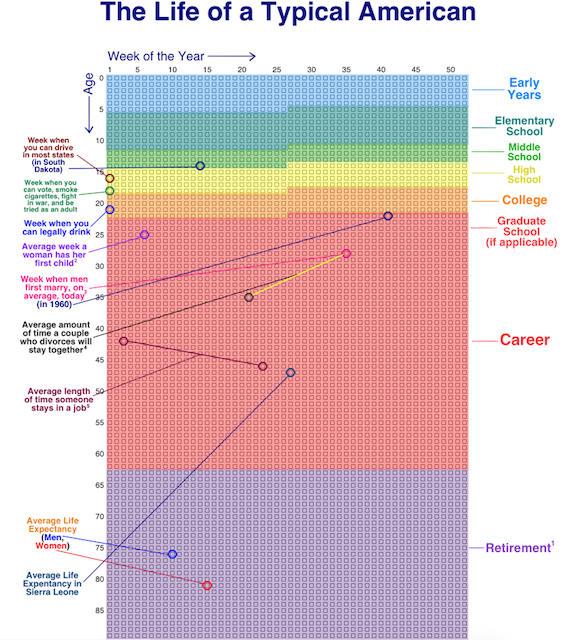
One of his most famous posts, back in 2014, urged readers: visualize your life in years, your life in months, your life in weeks, your life in number of remaining SuperBowls…to appreciate what you do with your time.
For example, I’ve got got 2860 of my weeks behind me. It’s tempting to use these kinds of visualizations for dismay; certainly they can lead to existential angst and even more productivity dysmorphia. “See?” one might yelp! “I have even less time to make the widgets! To earn the money!” And yet, as we’ve seen over the last two weeks, that attitude just leads to focusing more on the quantifiable value you create for others; we want to look at quality, not quantity.
But, we can still turn to Urban for guidance. As a follow-up to his macro look at the finitude of life, he developed a way to organize and examine our lives at the micro level in 100 Blocks a Day.
Inspired by Urban, nomadic programmer Jama of Notion Backups, has identified a way to pause and reflect, giving perspective on where you are, chronologically speaking, in your day (rather than in your life). Rectangles.app gives you a quick glance at how much of today has gone by, in ten minute increments, as of the point in your day when you click the link. Click later in the day, more boxes turn green.

For example, when I visited and took this screenshot, I’d made it through 93 1/3 ten-minute blocks in my day.
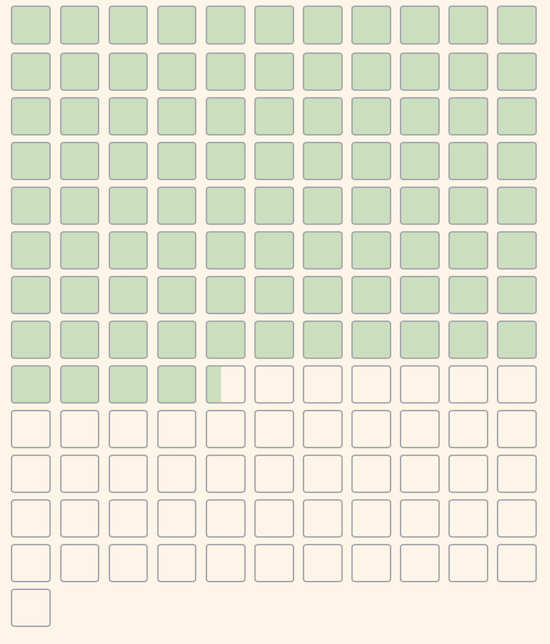
When faced with how much of your day has passed and how much is left, you might have the following reactions:
- Yikes, I’d better get cracking! (A good motivation if you’ve been staring at social media or playing a video game for hours on end, for sure.)
- Yikes, I’ve been working and working, and I’ve only written 17 TPS reports and attended 5 hour-long meetings! (A likely sign of productivity dysmorphia creeping in around the edges.)
- Yikes, all I’ve done all day is work. I haven’t talked to anyone I love, I haven’t exercised or gotten any fresh air. I haven’t laughed. (And here’s where the magic might begin!)
If you’ve been experiencing signs of burnout due to toxic productivity, give this approach a try. Click on Rectangles and think about the day you’re having. Maybe even text the link to a friend, describe your day thus far, and get a reality check from someone who sees you more clearly.
HOW TO GET OFF THE HEDONIC TREADMILL & STOP KEEPING SCORE
If you’ve gotten this far in this blog series, you might recognize that you (or someone you care about) is experiencing signs of toxic productivity or productivity dysmorphia. If you have trouble valuing what you’ve already accomplished, and especially if you experience difficulty spending your time on anything you can’t point to as an accomplishment, this section is for you.
We aren’t going to begin by saying, “Stop doing so much work” because that’s too big a step. Instead, I’m going to ask you to review the forthcoming suggestions and pick one or two to try, and carve out time in your schedule for doing them. Consider, on your first day, taking two or three of those boxes above, and before they pass by and turn green, experiment. Walk. Nap, Meditate.
Take a Walk
Exercise is great for us — it clears our heads and lets us reset to that default mode network we learned about last week from Jay Dixit’s We’re Doing Downtime Wrong in NeuroLeadership.
Of course, not all exercise is equal. Yoga is supposed to be good for us because it’s (mostly) gentle on the body, it focuses on correct breathing techniques, it improves strength, balance, and flexibility, it eases pain and benefits cardiac health, it dissipates stress, and much more. But yoga’s particularly advantageous for drop-kicking toxic productivity because there’s no scorekeeping.
Yes, I suppose you might feel competitive with the person next to you in class (not that you have to take a class) who has a more fluid downward-facing dog than yours. But in general, completing a yoga class feels less like, “I am a valid person because I can check today’s yoga off my list” and more, “Wow, my neck is no longer making that clicky-sound when I turn to the right!”
Contrast this with golf, for example, famously called, “a good walk spoiled.” (And no, trivia buffs, Mark Twain didn’t say that. He died in 1910, but the first reference to it was in 1948. The originator is a mystery.) Golf, indeed any game that involves precision and scorekeeping, probably isn’t going to help decrease your sense of always chasing after the next accomplishment, the next win.
Let’s start by stopping. Let’s stop counting our steps and counting the filled rings. (I’m not saying you can’t monitor your health-based metrics, but try strapping your Fitbit to your ankle to keep yourself from obsessively checking your step count.)
The great thing about walking is that there’s very little else of a truly productive nature, in terms of output, at least, that can be done while walking. You can’t handwrite, and while you can type or dictate into your phone, anything more than the odd inspiration is going to slow your pace and then stop you altogether, either because you’ll have forgotten to walk or you’ll fall right into a fountain.

For your mental health, the best thing you can do is just walk and explore your thoughts. Of course, that can be scary. Sometimes, the basis of toxic productivity is that one keeps working to avoid one’s thoughts. (Therapy can really help with that. Nudge, nudge.)
If you’re truly uncomfortable being alone with your own thoughts, try listening to soothing music or, if you must, a podcast. But the idea of this particular exercise (no pun intended) is to ease you into the notion of being comfortable doing nothing that earns you gold stars, nothing to check of the list. Try to walk to just walk.
One resource that might help is 52 Ways to Walk: The Surprising Science of Walking for Wellness and Joy, One Week at a Time by Annabel Streets.
Toxic Productivity Part 2: How to Change Your Mindset
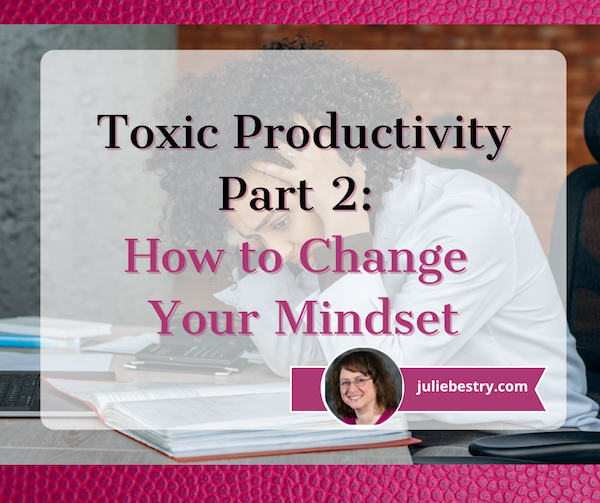
Last week, in Toxic Productivity in the Workplace and What Comes Next, we addressed systemic toxic productivity, when the workplace demands a seemingly endless series of achievements, undue (and unreciprocated) loyalty, and more of one’s heart, soul, and time than is reasonable. We also touched on the concept of personal toxic productivity, or productivity dysmorphia.
Going forward, we’re going to look at what we can do to give ourselves some grace and separate our productivity from our identity. Today, we’re focused on changing the way we think about ourselves and what we accomplish.
But first, let’s look at three stories that illustrate what toxic productivity is not.
WHAT TOXIC PRODUCTIVITY IS NOT
Story #1: At the end of April, my delightful colleague Linda Samuels wrote a blog post entitled How to Successfully Let Go Now Even If It’s Only For Today. In that post, she described how she enjoys getting things accomplished and often feels compelled to do so. She had a list of what she intended to accomplish on that particular Sunday, but was beckoned by the beautiful spring wearther and instead enjoyed a day in nature with her husband. In my blog comment, I gently teased her:
LOL, I’m glad you let go, but I think I see your problem right away, Linda. You had a to-do list for a Sunday. Sunday is the weekend. You’re not supposed to DO anything on the weekends except eat, play, and be entertained in the first place! 😉 No housework, no work-work, just enjoying yourself. I’m glad you let go; now we need to help you plan letting go as your weekend task so you don’t even try to work!
Linda is not an example of toxic productivity. She’s self-driven, but she also knows how and when to let go and grant herself buffer time to enjoy life.
Story #2: Another colleague (we’ll call her X), is a real go-getter. She had been working to create a virtual course, but has not yet made it go live because she’s so busy with her client load and is booked through the end of the summer. Disappointed that she hasn’t completed this combined educational/marketing tool, we’ve pointed out that the whole purpose of making people aware of one’s expertise is to get clients, and she already has more clients than spaces on the calendar! The girl is in serious demand!
Meanwhile, a few months back, X contracted COVID. Luckily, she had very mild symptoms, but of course she was quarantining. With no work to do, she headed outside and spent her quarantine weeding her garden! (Apparently, X didn’t know that the only acceptable reaction to being ill is to mope, wear fuzzy socks, and intersperse reading trashy magazines with bingeing guilty pleasure TV!)
X is also not an example of toxic productivity. She’s a product of a particular cultural background that especially prizes hard work and efficiency, but she also enjoys vacationing with her husband and entertaining friends around her pool.
Story #3: My BFF is a full-on, leaning-in career woman now that her children are all grown, but I recall a time when, for the 43rd conversation in a row, I was giving her a hard time about working so hard. She was raising four kids, volunteering in many realms, and though she had a bad case of bronchitis, was — as I was speaking with her on the phone — making cupcakes for a school bake sale!
As only a BFF can push, I pointed out that 1) she was sick and did not need to be doing anything for anyone else, 2) she could have sent her husband to the store to buy cupcakes, and 3) nobody wanted her bronchitis-germy cupcakes anyway! (I’m sure my voice went up three octaves by the time I got to the end of my diatribe.)
If I didn’t know better, I might think my BFF might be an example of toxic productivity. But she’s actually an example of systemic expectations of mental load, emotional labor, and American women unintentionally embracing the societal view that a woman’s value is based on what she does for others. (For superb writing on how to counter this, check out Emotional Labor: Why A Woman’s Work Is Never Done and What To Do About It, by my colleagues Regina Lark and Judith Kolberg.)



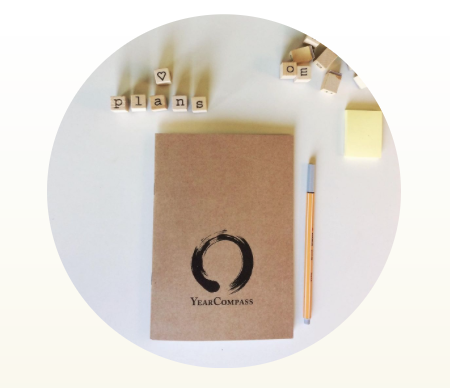

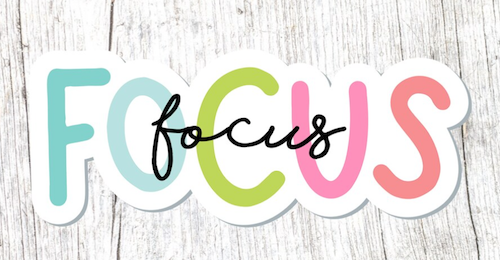

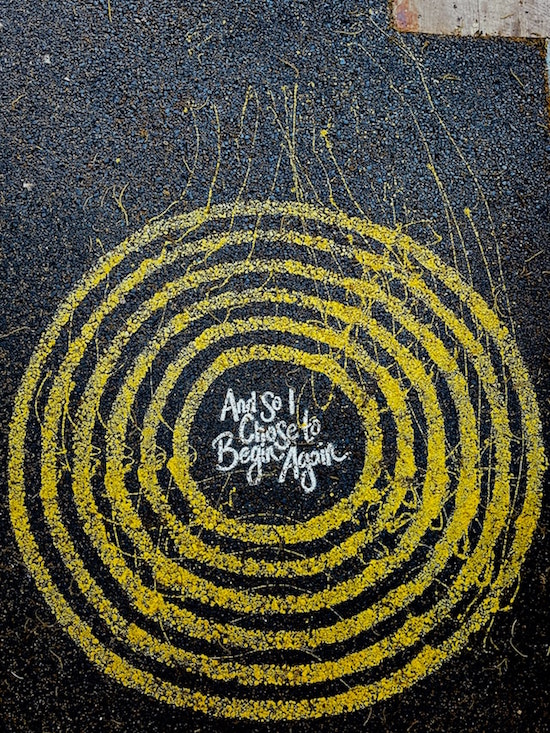


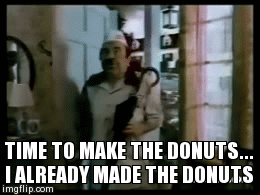












Follow Me